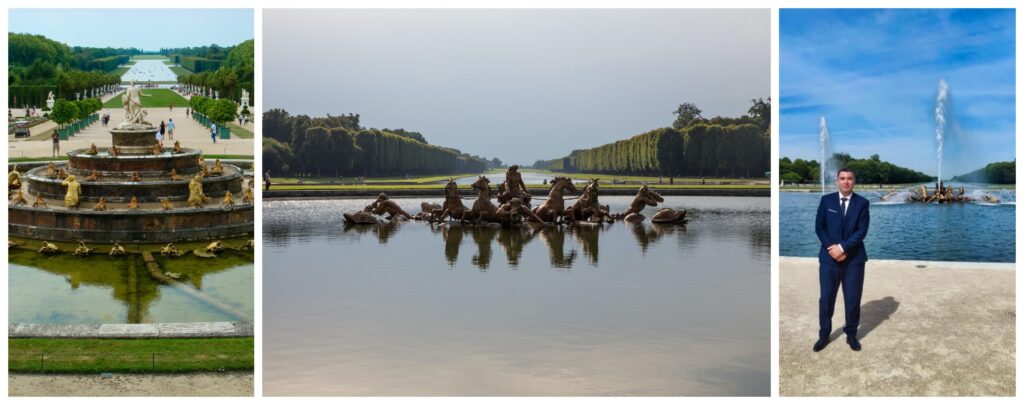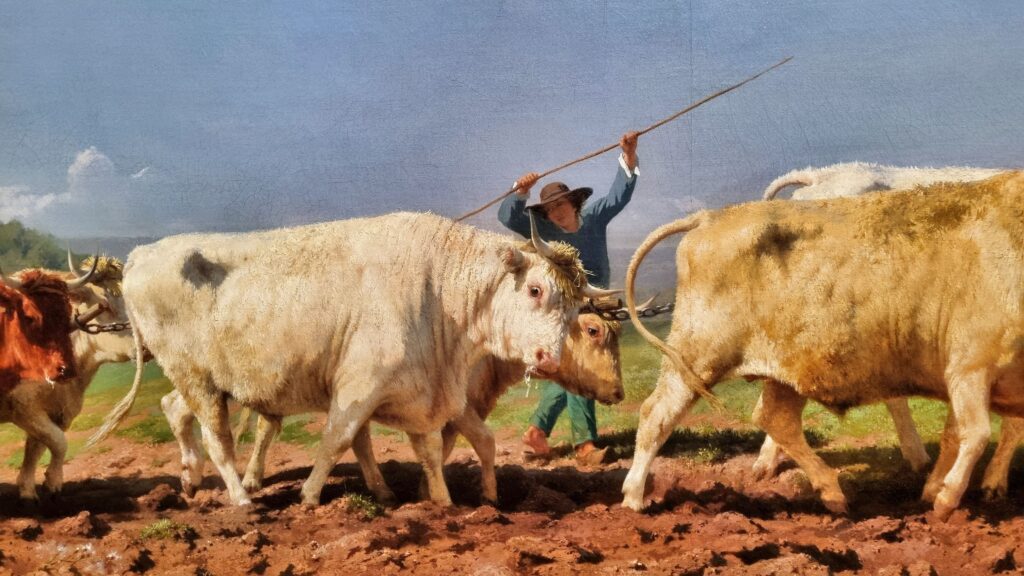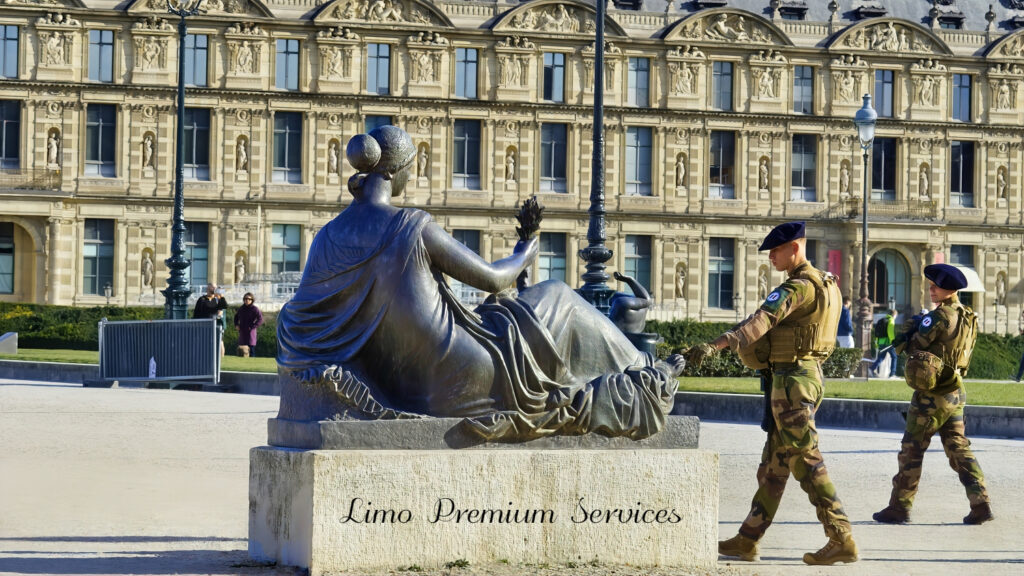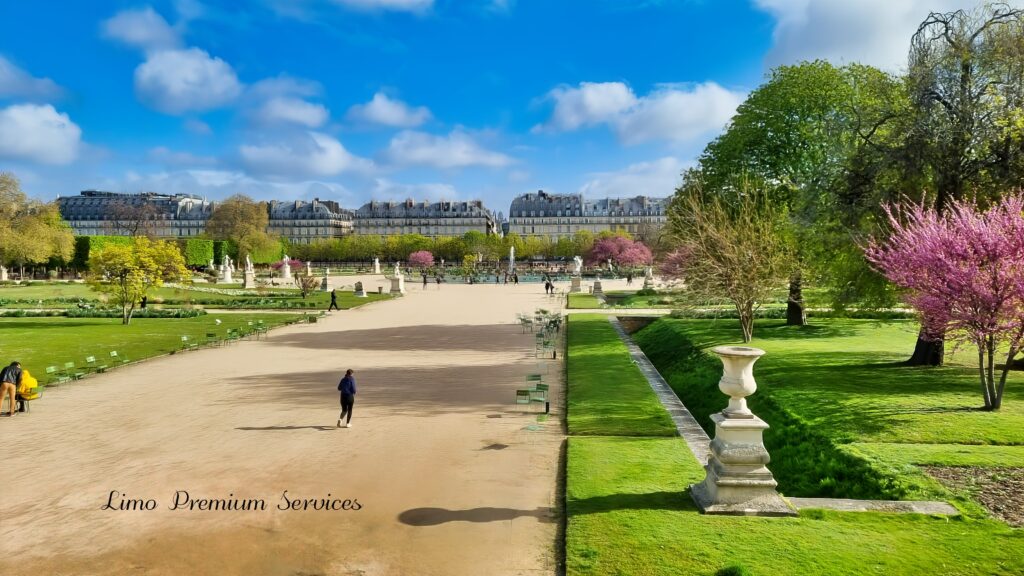The Versailles Gardens are a work of art that must be seen to be believed. They are massive and yet so intricately designed, providing endless opportunities to lose yourself in their magic. And there is no better way to enjoy this than with a car tour of the Versailles Gardens!
With our premium limo services, you can take in more of the park without any of the hassle. The convenience of a car tour makes this ultimate French destination as easy and enjoyable as possible.
We are trained private drivers who specialize in Paris tours. We get you from the city to Versailles and back safely and efficiently, allowing you to relax and take in the wonderful sights before you.
Don’t worry about traffic, scheduling, or figuring out how to navigate the grounds of Versailles. We take care of all of that for you!
If you are interested, contact us and schedule your car tour of Versailles!
About the Gardens of Versailles
These extravagant gardens are a must-see for anyone visiting the city. The Versailles Gardens are voted the most beautiful gardens in the entire Paris area, and it is easy to see why. Their size, scope, and ambition are simply stunning. Spreading out over 800 hectares (almost 2000 acres!) broken into areas with distinct character and function, this park is as beautiful as it is enormous.
The design and execution helped to define and codify the French formal garden, which dominated the country in the 17th and 18th centuries. Versailles has also proven to be one of the most influential garden designs in all of European history. Famous imitators include palaces throughout the continent, like the Hampton Court Palace and the Palace of La Granja. These so-called “Little Versailles” appear in Nymphenburg, Würtzbourg, Stockholm, and beyond.
This impressive impact is a major reason why UNESCO designated the park (as well as the palace) as a World Heritage Site in 1979.

The Seasons in Versailles
Whatever time of year you come to Versailles, you’ll find that the season provides its own unique charm. There is never a bad time to see these gardens.
In spring in Versailles, the flowers are in their full color. These are exciting months here, as the optimism of the season seems to take over the grounds. The fountain shows also begin again after their winter hiatus, providing entertaining water shows using the same engineering that Louis the Great commissioned in the 17th century!

By summer in Versailles, everything is warm and sunny here at the palace. The plants are at their height, and life seems to be exploding all around you. And if the day is a little too warm? Don’t worry! My car has air conditioning.
Autumn in Versailles is yet another favorite for many visitors. It is around this time that the yellows and reds are on display, bringing with them their own melancholic beauty. Plus, things are beginning to cool off a bit.
Winter in Versailles may seem like a bad time to come, but really it can be quite an experience. The grounds are generally crowd free, and my car stays nice and warm!

See the Animals in Versailles
The grounds of the Versailles Gardens are so vast that they play host to a wide range of wildlife. This includes a wide variety of colorful insects like butterflies and ladybugs, which support plant life in the park.
There are also plenty of birds — including song birds, jays, storks, and ducks. Many bird enthusiasts find Versailles to be a treasure trove for spotting European species that they might not see back home.
You will also find a range of other wildlife like frogs, snails, and squirrels.
The animals that live in the gardens make it feel all that much more alive, and give that added sense of wonder for many visitors, especially kids!
Incredible Design from Versailles times
Something that can take a long time to sink in is just how artificial everything is. As Versailles was being created (a process that literally took hundreds of years!), the goal was to expand the gardens as far as the eye could see in every direction. There was no detail too large or small to attend to. So anything you see was a choice fit for a king.

There is no water canal or plant that isn’t in its chosen place, which is a truly mind boggling feat of both architectural design and engineering.
For a really shocking example, even the hills were produced by royal decree! Marie Antoinette had these created to resemble the mountains of her homeland in Austria. Creating these miniature mountains helped her to remember the best days of her life and ease the homesickness she often felt.
Inside these “mountains,” she had a grotto carved in. This could be her ultimate retreat. It even had a place to spy out and see who was walking by.
When you put the Versailles Garden into raw numbers, you can see just how impressive this park really is. It contains:
- 18,000 trees lining streets
- 43 kilometers (almost 27 miles) of walking paths
- 350,000 bushes and trees among the gardens
- 144,000 flowers
This is a truly monumental place to visit!
Let’s take a dive into the history of the gardens to see how such a herculean effort was achieved.

History of the Versailles Gardens
The gardens of Versailles began in 1661 when construction of the palace began. But it was the gardens that were the first priority. Louis XIV knew that these would be so vast and require so much effort that they needed a head start.
The first landscape architect to work on the gardens was André Le Nôtre. He has since gone on to become a legendary figure in garden design, as he laid down the most important elements and fundamental structure of the Versailles Gardens.
He’d already worked on projects with the architect who would be designing the palace itself, Louis Le Vau, and he was already employed as the principle gardener for Louis XIV when construction on Versailles began.
It was also Le Nôtre who designed the city of Versailles that extended beyond the palace — a place to house the industry required to supply such a vast royal abode. Both the city and garden layout went on to inspire none other than the great Pierre Charles L’Enfant. Who is he? The man who designed the layout of Washington, D.C.
The gardens required a massive amount of work just to become feasible. Versailles was originally chosen for hunting grounds by Louis’s father — and they sat on swampy land. That meant that running water had to be redirected away from the land to dry it up enough to work it into the gardens we know and love today.
In 1664, it seemed to Louis XIV that his grand work was complete. To celebrate his victory, he held a massive celebration there. It was a week of luxurious revelry, to be sure, but the King of France was not satisfied. The palace could not provide beds for even half of the visitors, and the gardens, though impressive, were not unimaginably so.
It was time to get started on an even greater campaign of construction.

The Gardens Grow Again (and Again, and Again…)
The next four years saw many of the most famous features of the gardens added or completed. Fountains were installed, as well as statuary that brought with it plenty of solar imagery (Louis XIV was known as the “Sun King”).
Also added were many bosquets, an important feature for the French formal garden that Le Nôtre was pioneering. Bosquets are a series of tree plantings, each its own species. The designer is meant to vary the forms, so that the eye can examine and compare the different shapes that trees can take.
You can see bosquets, and all the design ideas of the French formal garden style, on the car tour!
The Grotte de Thétys was also completed at this time. It is a massive and critical element to the gardens, forming as it does the most direct symbolic tie between the King of France and solar mythology. The grotto also serves an engineering component, holding up the water reservoir that is used in the hydraulic system for the fountains.
Following this phase of construction came the Grand Canal. This feature allowed royalty to hold boating parties at Versailles using this man-made river.
There was also a push to use the gardens to produce food. This includes the famous Orangerie, which would protect orange trees during the cold months (much like the one in Paris by the Louvre). Louis XV’s chef was able to walk out into the gardens to pick fresh fruits and legumes for the day’s meals.
A Continuing Legacy
Multiple building campaigns followed, each one adding, extending, and modifying features of the grounds. Over the course of centuries, almost everything has been changed many times. And all of that effort and labor was done without the benefit of modern machinery. It was constructed by hand! More than 30,000 artisans and 2,000 consultants worked to create this world heritage site.
Each wave of construction more or less fit the original idea of Versailles — humanity taming nature and bringing it into perfect order through an almost militaristic discipline and expenditure of resources. But this approach changed when Louis XVI came to power. In the 1770s, he started a push to move away from the French formal garden style that architects like Le Nôtre had popularized and toward the English landscape garden.
Spearheaded by William Kent, the English landscape garden provided far less symmetry than the French style it replaced. Instead, it sought out a more rustic look that embraced the unevenness of nature itself. This was heavily influenced by an idealism for the past, which can be seen in the creation of “ruins” in the form of classical and medieval buildings.
It is during this time that Marie Antoinette made her mark on the gardens with her Petit Trianon, which served as her own retreat from the pressures of court life. Architect Richard Mique filled her portion of the gardens with plenty of naturalistic details that shine as stellar examples of the English trend.
With the French Revolution toppling the monarchy of Louis XVI, few changes came to the gardens — though the palace itself was ransacked. Through the rise and fall of Napoleon, the restoration of the Bourbons, the coming of a new monarchy, and the rise and fall of yet another Napoleon, the gardens were maintained in the state that they were at the end of the 18th century.
This only changed when, in the late 19th century, the palace and garden of Versailles became a museum. Director Pierre de Nolhac laid the groundwork for preserving things for future generations, even turning the clock back a bit to be more representative of this magnificent wonder of the world.
Highlights of the Versailles Gardens Car Tour
The car tour brings you the most comfortable and safe way to see all of the gardens in a single day. We offer several different options for your tour, and you can customize to your heart’s content!
When you hire us for your Versailles Gardens car tour, you avoid the hassle, tickets, delays, and cancellations that can come with public transport. It’s also a lot faster. The train ride from Paris to Versailles is about an hour and a half (on a good day!). A ride in our driving service takes half as long.
In this section, we’ll go over the details of the car tour, as well as the options you have to make it your own!
The Car Tour in Versailles from Paris
We are both drivers with full VTC licenses, which is a specialty license specifically for tourism chauffeuring. When you hire one of us as your driver, you benefit from years of experience sharing the wonders of Versailles with people from around the world.

This really is the best way to see the gardens and palace of Versailles.
The car is a Mercedes Van Class V, which means you can expect:
- Comfort and Safety
- AC means you can stay cool in the summer and warm in the winter
- High seats that provide the best views
You can also always go where you want. Your driver can wait with the car or pick your group up anywhere at Versailles. This added convenience means you can explore on foot and by car — the best of both worlds!
We can also continue to provide driving services for your entire stay in Paris! We provide all kinds of driving tours, including tours to the Normandy Beaches, Claude Monet’s house and gardens at Giverny, and in-city destinations. We love to provide our clients with safe and convenient transportation solutions during their Paris vacation!
Add a palace-licensed Tour Guide
We also work with our recommended tour guides, trained by the Palace of Versailles. This add-on can really expand your visit!

Every guide has a prestigious education in art history and amazing English language skills. They can give you accurate and fascinating information while your driver safely takes you wherever you want to go.
With a tour guide, you can always hop out of the car and get up-close views, as well as enter the many interesting features along the way — including the many grottos and sectioned off spaces.
The tour guides we recommend provide a variety of guided tours that take advantage of having your own personal driver. These include:
- Versailles Highlights from Paris : This briefest option brings you by the most important features of Versailles. The tour guide will accompany you from Paris or meet you at the gates. You will enjoy the Palace big rooms of the King and the Queen and have a quick understanding of what makes Versailles so famous.
- Half Day: Taking a little more time, you can go more in-depth on a few of your favorite sites.
- Full Day: With an entire day (including a lunch break), you can really get to know the palace and gardens.
- VIP Tour: Go behind the locked doors to get an insider’s view of Versailles. This tour is VIP because the reservation alone is 600€ for Versailles Museum. But you will be alone with an accredited tour guide to explore the most secure and exclusive area of the Palace : The King’s private apartment – Le Petit appartement du Roi – Versailles.
- Royal Day: Experience the day-to-day life of royalty like the Sun King Louis XIV or Queen Marie Antoinette.
- Art and Power of Versailles: Get the inside scoop on how Versailles was a pleasure palace built by Louis XIV to consolidate absolute power.
Transportation Options at the Gardens
If you want to do a little exploring on your own once we arrive at the gardens, Versailles gives you three main options:
- By Foot: If you are looking for a little exercise and the ability to really soak up the experience, walking the miles of pathways by foot is a great option. The only downside is that you will see only a small fraction of what Versailles has to offer, and comfort will depend entirely on the day’s weather and crowds.
- By Bike: This is another way to enjoy Versailles while getting in some invigorating activity. It allows you to see much more of the grounds than walking. But like walking, it can be much less enjoyable if you get bad weather or excessive crowds.
- By Golf Cart: This is a particularly good option if you or someone in your group has low mobility but still wants to see things close up. Large family groups love this option! The only real disadvantage is that you are low to the ground, unable to see everything around you.
Looking for More Gardens Near Paris?
After your visit to Versailles, you might be interested to see all the other famous gardens in or near Paris.
This is an area filled with legendary gardens, and with your own personal driver service, you can easily visit them!
Below, we’ve listed a few of the most beloved in the area. But there are plenty more, so don’t be afraid to ask for suggestions on your next trip to Paris.
Giverny

Giverny is the place Claude Monet spent the last four decades of his life. The expansive gardens became an ever-growing obsession for the artist, who often began his day by writing extensive instructions to his gardeners.
This garden provided the subjects for some of his most popular works, including his famous Water Lilies. Today, Giverny still features thousands of flower species from Europe, Japan, America, and Africa.
Château de Brie
Rosa Bonheur remains the most famous and beloved painter of animals from the 19th century. It is here at her château that she kept many live animals to paint from directly.
The gardens also gave her plenty of inspiration, not to mention a place to encounter wild animals — which she often painted.

The château has become quite the destination, especially as art lovers begin to rediscover Bonheur and her work. Now, you can eat a meal here and even stay the night!
Jardin du Luxembourg

This might be our favorite. Built on the orders of none other than Marie de’ Medici, this enormous garden lies in the middle of the city’s 6th arrondissement.
The famous palace with its large pool provides a relaxing place to eat a picnic lunch, and the area has been exquisitely preserved.
This is also a perfect option if you have children with you, as the garden provides many activities that kids enjoy.
Botanical Gardens – Jardin des Plantes

This is another great option for kids, as this area in Paris has a zoo, natural history museum, and (of course) a wonderful garden.
Children get to learn a lot while also having fun. Meanwhile, parents can learn a lot too while taking in the beautiful sights.
Tuileries Gardens by the Louvre
This is another garden in Paris, found near the Louvre and offering views of the Arc de Triomphe. While it is beautiful and charming, it is pretty consistently crowded.

It is also not quite as well maintained as other gardens in the city. Nevertheless, it is a garden built for kings, complete with monuments, sculptures, and landscape art.

Visit the Versailles Gardens by Car!
Want to see the gardens of Versailles in total comfort? Do you want to skip the headache of travel and just focus on the beauty and stunning sites that Versailles has to offer? Then contact us!
Our Versailles Garden car tour is by far the easiest and more fun way to see this legendary site. And when you add on a tour guide, you can learn even more!
So what are you waiting for? Let’s plan together a car tour of Versailles in advance.